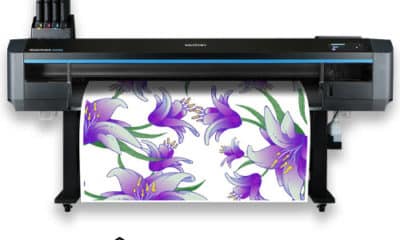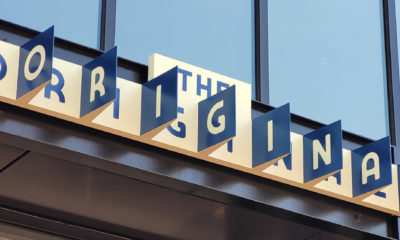Design
Lawrin Rosen Provides Insights From 37 Years of Sign-Design Experience
Type and imagery trends change, quality doesn’t
Published
9 years agoon

Lawrin Rosen is president of ARTfx Signs (Bloomfield, CT).
When asked where and when my creative streak began, I often mention my grandmother, who frequently visited when I was a kid. One day, while I was coloring, she asked for my pad and a few crayons, and proceeded to draw an elaborate panorama of the Southwest filled with cowboys and Native Americans on horses. Unbeknownst to me, this woman was an accomplished illustrator with an art degree from the Cooper Union Institute. So began the impetus for my career in art.
Approximately 15 years later, at the Hartford Art School, I studied painting and the history of art and architecture. During summers and Christmas breaks, a friend and I painted large, geometric murals, an interior-design trend referred to then as “supergraphics.” We’d sketch out an assortment of colorful shapes – squares, diamonds, trapezoids, etc., and hope for commissions painting the designs in playrooms, dens and childrens’ bedrooms. In 1978, I began my career at a sign/billboard company as a patternmaker, projecting and tracing layouts, and tediously correcting typestyles and pictorials by hand. That was my crash course in typography and sign layout. The typestyles popular at the time became etched in my brain – Helvetica, Times Roman, Optima, Clarendon, Flash, Avant Garde, Brush Script and others. By the time I was promoted to art director, which began a four-year stint churning out hand renderings of signs and billboards, I had nearly become a human XY plotter.
I’ve spent 38 years in the business watching design and typography trends come and go. Preferences for geometric shapes have also changed with the years. During the ’80s, every sign seemed to have radius corners or radius ends. Around the late ’90s, slightly bowed arches replaced hard-angled trapezoids, and, for years thereafter, nearly every pylon sign included an arched top, bowed center or both. I’ve tried to avoid trendy design, but clients have preferences that can be faddish…or worse, dated. An out-of-date sign design has the architectural relevance of a mullet. One key difference: mullets grow out, whereas unfashionable signs often linger for a long time.
At ARTfx, we design approximately 50% of what we build. Clients often allow us creative leeway because we have an established reputation. Therefore, it’s our responsibility to listen closely, and then spend time analyzing what drives the particular design – an existing logo, an architectural style, a color pallete, material preference, general functionality, existing signs to match, a budget constraint, or merely what’s allowed within the specific municipality or governing force. Coupled with those considerations, the client’s level of expectation is a big factor. We won’t waste time designing a show-stopper if an average sign suffices.
When the local Habitat for Humanity came to ARTfx with their logo for a new pylon sign, we knew it was going to be price-driven. If we were going to get the job, it meant lowballing or coming in with a look they couldn’t refuse. ARTfx isn’t big on free design work, but being that our designs carry a copyright and we ask up front for confidentiality, I feel safe occasionally sharing proprietary ideas on speculation. For Habitat, I came up with what I was confident would grab them – using an element of the logo for the pylon base. Sure enough it worked.
AdvertisementMany ARTfx designs begin on my drafting table, which I keep well organized. For Habitat, once I had my idea, I belted out little more than a scribble for the art department, where the idea was translated into presentation format using CorelDRAW software, our program of choice. To prepare files for production, we eliminate unnecessary information and convert the file to .EPS. We use Gerber’s Omega and Composer software and equipment to prepare files for plotter cutting, inkjet printing and CNC routing.
Hassett & George, a law firm in our area, came to ARTfx with no logo and a reasonable budget, but the sign would be installed in a town that tightly regulates signage square footage. The client requested a sign be installed on a brownstone pedestal because they admired others in town. I thought it was a good idea; brownstone has been quarried in this area for approximately 200 years, and I like using local materials. However, the mason quoted the pedestal at $8,500, which threatened to bust our budget; we had to regroup.
In municipalities where square-footage constraints stifle sign sizes, I often accentuate the visual impact by emphasizing peripheral elements. For instance, I’ll thicken a sign’s support legs, create pedestals, incorporate detached crown moldings and place greater attention on address panels. I call this technique “flying above zoning radar.” For Hassett & George, we had to split 32 sq. ft. between two signs, and the other sign comprises an 18-sq.-ft. directory.
With the brownstone pedestal removed from consideration, I needed another mounting solution to enhance the overall stature. Stretching unique design elements beyond the expected is often my sure-fire means to defy the faddish use of shape and structure. With the Hassett & George project, I felt that exchanging traditional legs for ornamental metal work could work successfully.
Surprisingly, the town’s design-review committee confronted us because our original layout depicted fairly wide rail work. They said the plan was a bit ostentatious, and that we were trying to trick them with elements that augmented the sign’s mass. It’s difficult battling a design committee in a posh New England town; they often comprise sophisticated professionals, such as Ivy League-educated architects and MIT engineers, who have strong opinions. We eventually compromised on a reduced railing, as shown in the sketch and photo.
Another local project, Mallory Ridge, required a freestanding main monument that created a real design hassle. First, the project’s logo was difficult to interpret into signage because of the inordinately large “M”. Additionally, the client requested we introduce cultured stone from the apartment-building fascias into our design. The particular product brand was a mediocre grade only available in unusually awkward and clumsy sizes. Beyond that, there was no logical location on the site to erect a horizontal sign. The only piece of suitable road frontage was immediately backed by a steeply descending grade into the gulley of a retention pond.
AdvertisementOut of necessity, we designed a single-column structure, and designed the sign panel to sit cantilevered, away from the road, over the banks of the pond. The configuration turned out quite nicely, and, in my opinion, without a trendy design. In that sense, the challenges were successfully solved with a style that should survive well into the future. In other words, it has a long architectural shelf life.
ARTfx has begun to experiment with 3-D extrusions using SketchUp, an architecturally based program that spins a shape’s elevation in virtual space while the designer enhances any elevation or component as it spins. Although the lines are somewhat unrefined, and the program is not entirely typography-friendly, the drawings, once extruded and detailed, can be brought back into programs such as Corel for refinement. This allows us the advantage of showing the client their future sign as it will appear in three dimensions, and it serves as a great visual reference for production in fabrication drawings.

SPONSORED VIDEO
Introducing the Sign Industry Podcast
The Sign Industry Podcast is a platform for every sign person out there — from the old-timers who bent neon and hand-lettered boats to those venturing into new technologies — we want to get their stories out for everyone to hear. Come join us and listen to stories, learn tricks or techniques, and get insights of what’s to come. We are the world’s second oldest profession. The folks who started the world’s oldest profession needed a sign.
You may like

ISA Enters Strategic Partnership with The Wrap Institute

Summa Releases GoProduce Flatbed Edition 3.0

Preserving the Past with The San Jose Sign Project – Part 1
Subscribe

Bulletins
Get the most important news and business ideas from Signs of the Times magazine's news bulletin.
Most Popular
-

 Business Management1 week ago
Business Management1 week agoWhen Should Sign Companies Hire Salespeople or Fire Customers?
-

 Women in Signs1 week ago
Women in Signs1 week ago2024 Women in Signs Award Winners Excel in Diverse Roles
-

 True Tales2 weeks ago
True Tales2 weeks agoSign Company Asked to Train Outside Installers
-

 Editor's Note5 days ago
Editor's Note5 days agoWhy We Still Need the Women in Signs Award
-

 Maggie Harlow2 weeks ago
Maggie Harlow2 weeks agoThe Surprising Value Complaints Bring to Your Sign Company
-

 Line Time1 week ago
Line Time1 week agoOne Less Thing to Do for Sign Customers
-

 Product Buying + Technology6 days ago
Product Buying + Technology6 days agoADA Signs and More Uses for Engraving Machines
-

 News2 weeks ago
News2 weeks agoMUTOH Partners With Wasatch for RIP Software Package












